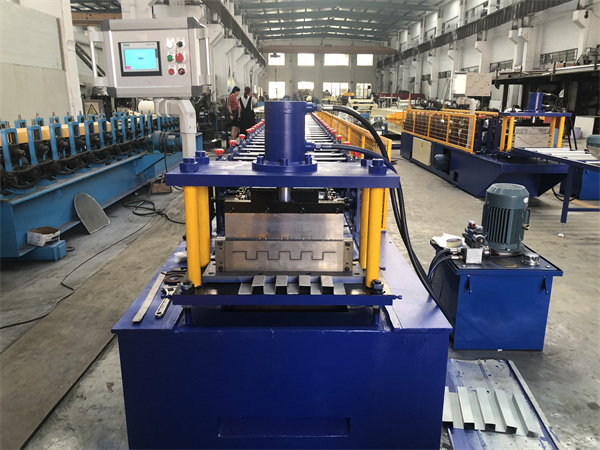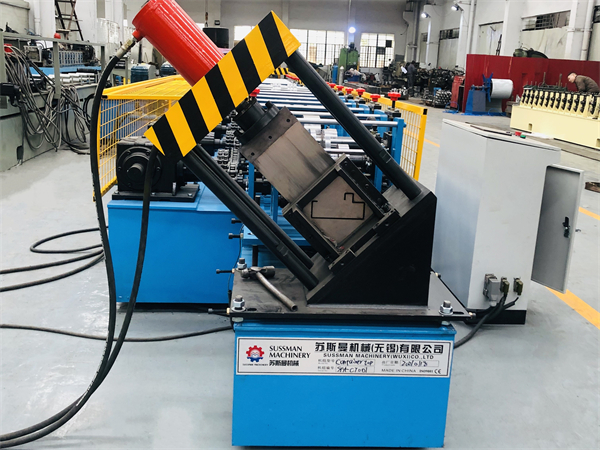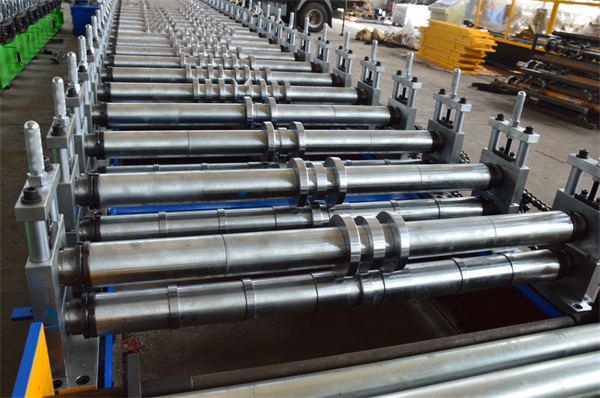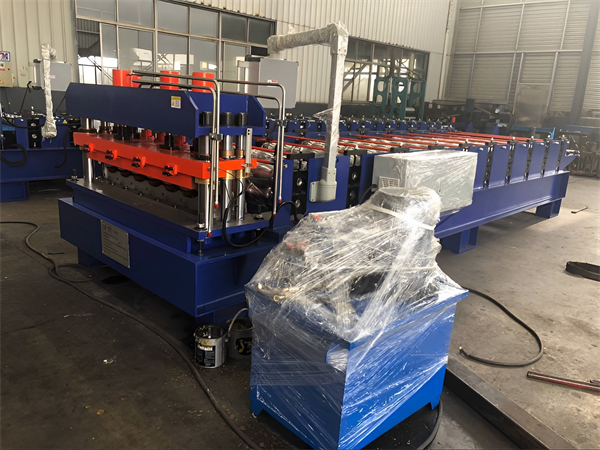In the world of construction, precision, speed, and cost-effectiveness are paramount. One technology that has revolutionized the manufacturing of building components is the C Shape Purlin Roll Forming Machine. This innovative machine plays a pivotal role in crafting C-shaped purlins – crucial structural elements that support roofs and walls. Let’s delve into the realm of roll forming technology and explore how this machine is reshaping the construction landscape.
Roll forming machines are automated systems designed to transform raw materials into finished products through a continuous bending process. The C Shape Purlin Roll Forming Machine specializes in producing C-shaped purlins, which resemble the letter “C” in cross-section and are widely used in modern construction for their exceptional load-bearing capabilities.

Understanding the Components of a C Shape Purlin Roll Forming Machine
A C Shape Purlin Roll Forming Machine comprises several intricate components working in harmony to achieve precise and consistent results. These include:
1. Uncoiler: This component feeds raw materials, typically metal coils, into the machine for processing. It ensures a steady supply of material throughout the operation.
2. Roll Forming Stations: The heart of the machine, these stations consist of a series of rollers and tools that gradually shape the flat material into the desired C-shaped profile. The number of stations determines the complexity of the purlin’s design.
3. Punching and Cutting Mechanisms: These components are responsible for creating holes, notches, or cuts in the purlin as needed for installation. Computerized controls ensure accuracy in these processes.
4. Guiding System: To prevent material misalignment during the forming process, a guiding system assists in maintaining a consistent feed into the roll forming stations.
5. PLC Control System: Modern C Shape Purlin Roll Forming Machines are equipped with programmable logic controllers (PLCs) that allow operators to control and adjust various parameters, such as feed rate, roll pressure, and cut lengths.
Automation and technology integration play a pivotal role in enhancing the accuracy and efficiency of C Shape Purlin Roll Forming Machines. The combination of precise tooling, computerized controls, and automated processes ensures that each purlin produced meets strict quality standards.
Advantages of Using C Shape Purlin Roll Forming Machine
The adoption of C Shape Purlin Roll Forming Machines offers a myriad of advantages for construction companies and the industry as a whole.
Cost-Efficiency in Production: Traditional methods of crafting purlins involve manual labor and multiple processing steps, resulting in higher labor costs and material wastage. In contrast, roll forming machines optimize material usage and significantly reduce labor requirements. This leads to cost savings in terms of both raw materials and production hours.
Consistency and Precision in Forming Purlins: C Shape Purlin Roll Forming Machines deliver consistent and precise results with every run. The machine’s controlled process ensures that each purlin maintains uniform dimensions, eliminating variations that may arise from manual manufacturing. This consistency translates to improved structural integrity in the final construction.
Time-Saving Benefits for Construction Projects: The construction industry operates on tight schedules, and any delay can have cascading effects. C Shape Purlin Roll Forming Machines contribute to project efficiency by producing purlins at a rapid pace. Moreover, the automation eliminates the need for manual intervention between each purlin, further expediting the production process.

Factors to Consider When Choosing a C Shape Purlin Roll Forming Machine
Selecting the right C Shape Purlin Roll Forming Machine is a strategic decision that requires careful consideration of several factors.
Material Compatibility and Thickness: Different construction projects may require purlins of varying materials and thicknesses. A suitable roll forming machine should be able to handle a range of materials, from galvanized steel to aluminum, and accommodate different thicknesses without compromising quality.
Customizability and Flexibility: As construction designs become more intricate, the ability to customize purlin profiles becomes crucial. Opt for a machine that offers flexibility in adjusting dimensions, hole placements, and other features to match specific project requirements.
Production Capacity and Speed: Evaluate your project’s scale and deadlines when choosing a machine. Higher production capacity and speed are advantageous for large-scale projects, while smaller machines might suffice for smaller ventures.
Installation and Maintenance of C Shape Purlin Roll Forming Machine
Proper installation and ongoing maintenance are pivotal for ensuring the longevity and performance of your C Shape Purlin Roll Forming Machine.
Proper Setup and Installation Guidelines: Follow manufacturer guidelines meticulously during installation. Ensure the machine is placed on a stable foundation to prevent vibrations that could affect its precision. Calibrate the machine accurately, paying close attention to alignment and leveling.
Routine Maintenance and Care: Regular maintenance is essential to prevent wear and tear and maintain consistent output quality. Lubricate moving parts, check for loose screws or bolts, and inspect the electrical and hydraulic systems periodically. Implement a maintenance schedule to address potential issues proactively.
Troubleshooting Common Issues: Despite rigorous maintenance, occasional issues may arise. Common problems include material misalignment, irregular forming, or cut inaccuracies. Familiarize yourself with the troubleshooting procedures outlined in the machine’s manual, and seek professional assistance if necessary.
Case Studies: Real-World Applications of C Shape Purlin Roll Forming Machines
The impact of C Shape Purlin Roll Forming Machines on construction projects is best illustrated through real-world case studies.
Example 1: Large-Scale Commercial Building: A construction company tasked with erecting a sprawling commercial building utilized a C Shape Purlin Roll Forming Machine to produce purlins of varying lengths and dimensions. The machine’s speed and precision allowed for seamless integration with the project’s tight schedule, resulting in substantial time and cost savings.
Example 2: Sustainable Residential Complex: In a sustainable residential project, the use of a roll forming machine contributed to minimizing material wastage. The machine’s accuracy ensured that purlins fit precisely into the building’s energy-efficient design, reducing the need for additional adjustments and alterations.
The implementation of C Shape Purlin Roll Forming Machines in these case studies not only accelerated construction timelines but also showcased the machines’ adaptability to diverse architectural requirements.

Future Trends in Roll Forming Technology for Purlins
The evolution of roll forming technology promises exciting advancements that will further shape the future of purlin manufacturing.
Potential Advancements in Automation and AI: As artificial intelligence continues to make inroads into various industries, the roll forming sector is no exception. AI-powered machines could enhance predictive maintenance, optimize production parameters, and refine the forming process to even higher levels of precision.
Sustainable Manufacturing Practices: With growing emphasis on sustainability, roll forming technology is likely to incorporate greener practices. This could involve the use of eco-friendly materials, energy-efficient processes, and strategies to minimize material wastage.
Integration with Other Construction Technologies: Roll forming machines could become integral components of integrated construction technologies. Collaborative robots, 3D printing, and advanced software could work in tandem with roll forming machines, streamlining the entire construction process.
Comparison with Traditional Purlin Manufacturing Methods
Drawbacks of Traditional Methods: Traditional methods of purlin manufacturing are labor-intensive, leading to longer production times and inconsistent quality. Manual measurement and cutting can result in inaccuracies, leading to potential construction flaws.
Enhanced Benefits of Roll Forming Machines: C Shape Purlin Roll Forming Machines address these drawbacks by automating the entire process. They provide uniformity, precision, and speed, significantly reducing the margin of error. This shift from traditional methods to automated roll forming aligns with the industry’s push for efficiency and excellence.
Shift Towards Modern Manufacturing Techniques: The construction industry is gradually recognizing the efficiency gains offered by roll forming technology. As more companies transition from traditional methods to roll forming machines, the construction landscape is poised to witness improved project outcomes, reduced costs, and elevated construction standards.
Ensuring Safety and Compliance in C Shape Purlin Roll Forming
Safety and compliance are paramount when operating C Shape Purlin Roll Forming Machines to protect both workers and project outcomes.
Safety Measures for Machine Operators: Proper training for machine operators is imperative. Operators should be well-versed in machine operation, emergency shutdown procedures, and safety protocols. Protective gear, such as gloves and safety goggles, must be worn at all times.
Compliance with Industry Regulations: Construction industry regulations and standards vary by region. Ensure that your roll forming operations align with local safety and quality regulations to prevent legal complications and ensure the well-being of workers.
Importance of Training and Supervision: Regular training sessions and supervision are key to maintaining a safe working environment. Operators should be trained not only in machine operation but also in identifying potential hazards and handling emergency situations.
Economic and Environmental Impacts of C Shape Purlin Roll Forming
Reduction in Material Wastage: C Shape Purlin Roll Forming Machines optimize material usage, resulting in minimal wastage. Traditional methods often generate significant offcuts, which can drive up material costs and have adverse environmental impacts.
Energy Efficiency and Carbon Footprint: Modern roll forming machines are designed for energy efficiency. The reduction in energy consumption compared to traditional manufacturing methods contributes to a lower carbon footprint, aligning with sustainability goals.
Cost Savings for Construction Companies: The combination of reduced material wastage, streamlined production processes, and enhanced project efficiency leads to cost savings for construction companies. These savings can be redirected toward other aspects of the project, contributing to overall profitability.
Expert Tips for Maximizing Efficiency and Quality
Preparing Materials for the Roll Forming Process: Ensuring that materials are properly aligned and free from defects before feeding them into the machine can prevent interruptions and enhance the quality of the final product.
Regular Quality Checks and Adjustments: Implement a system of routine quality checks during production. This includes monitoring the purlins’ dimensions, ensuring hole placements are accurate, and verifying the structural integrity of the formed profiles.
Collaborative Teamwork in Production: Foster effective communication between machine operators, quality control personnel, and maintenance staff. A collaborative approach ensures that any issues are addressed promptly and that the production process runs smoothly.
Innovations in Roll Forming Techniques for Varied Purlin Shapes
The versatility of C Shape Purlin Roll Forming Machines extends beyond C-shaped profiles.
Adapting to Different Architectural Designs: Innovations in roll forming technology enable machines to adapt to various architectural designs. Whether it’s Z-shaped, U-shaped, or other profiles, modern machines can accommodate diverse requirements.
Multi-Profile Roll Forming Capabilities: Some advanced machines offer multi-profile roll forming capabilities. This means a single machine can produce different purlin profiles, saving space, reducing setup time, and enhancing operational efficiency.
Addressing Industry Demands for Versatility: The construction industry demands solutions that cater to unique project needs. Roll forming technology’s ability to produce a range of profiles aligns with this demand, providing construction professionals with the flexibility they require.
Challenges Faced in C Shape Purlin Roll Forming
Despite the benefits, challenges exist in the roll forming process.
Handling Complex Designs and Dimensions: While modern roll forming machines are highly capable, handling intricate designs with complex dimensions can pose challenges. It requires a meticulous setup and precise calibration to ensure the machine produces the desired results.
Addressing Machine-Related Glitches: Like any machinery, C Shape Purlin Roll Forming Machines may encounter technical glitches. These could range from sensor malfunctions to software errors. Manufacturers often provide troubleshooting guides to help operators resolve these issues swiftly.
Maintaining High-Quality Output Consistently: Consistency is essential in construction, and roll forming machines are expected to deliver the same high-quality output consistently. Maintaining this level of consistency requires careful monitoring, regular maintenance, and operator expertise.

Investing in a C Shape Purlin Roll Forming Machine: Long-Term Benefits
Return on Investment (ROI) Analysis: Investing in a C Shape Purlin Roll Forming Machine requires a comprehensive ROI analysis. While the initial investment might be substantial, the long-term cost savings, increased project efficiency, and enhanced product quality can lead to significant returns.
Competitiveness in the Construction Market: Embracing modern manufacturing technologies like roll forming can give construction companies a competitive edge. The ability to offer high-quality, efficiently produced purlins positions a company as an industry leader.
Enhancing Project Timelines and Reputation: C Shape Purlin Roll Forming Machines contribute to faster project completion, allowing construction companies to meet tight deadlines. Delivering quality results within shorter timeframes enhances the company’s reputation and fosters client trust.
Conclusion
The C Shape Purlin Roll Forming Machine embodies the intersection of precision, efficiency, and innovation in the construction sector. As construction projects continue to evolve, embracing this technology can usher in a new era of quality, speed, and sustainability. With its ability to shape purlins of various designs and sizes with unmatched accuracy, the roll forming machine is a beacon of progress for the construction industry. As we gaze into the future, it’s clear that the integration of roll forming technology will play a pivotal role in shaping the skylines of tomorrow.
FAQs
1. How does a C Shape Purlin Roll Forming Machine work? A C Shape Purlin Roll Forming Machine uses a series of rollers and tools to gradually shape flat materials into C-shaped purlin profiles. It automates the process, ensuring consistency, precision, and efficiency.
2. What benefits does roll forming offer over traditional manufacturing methods? Roll forming offers advantages such as cost-efficiency, consistent quality, and time savings. It minimizes material wastage and enhances structural integrity, setting it apart from labor-intensive traditional methods.
3. Can roll forming machines accommodate various purlin shapes? Yes, modern roll forming machines can adapt to various purlin shapes, including Z-shaped and U-shaped profiles. Some machines even offer multi-profile capabilities, catering to diverse project requirements.
4. How can I ensure the safety of machine operators using a roll forming machine? Proper training, adherence to safety protocols, and the use of protective gear are crucial to ensuring the safety of machine operators. Regular maintenance and supervision also contribute to a safe working environment.
5. What role does roll forming technology play in sustainable construction practices? Roll forming technology contributes to sustainability by optimizing material usage, reducing energy consumption, and minimizing material wastage. This aligns with the construction industry’s growing focus on eco-friendly practices.
